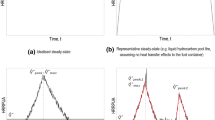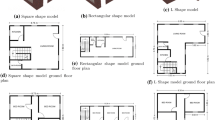Abstract
The fire ignited due to air conditioner (A/C) malfunctioning is studied numerically for a single room, two rooms with interconnection, two interconnected rooms with attached corridor and a two-storeyed building with stairs. Coupled finite difference and finite volume based open source solver, Fire Dynamics Simulator (FDS) is used for domain discretization and solution of governing equations. Heat release rate per unit area (HRRPUA) is varied in the single room case and temperature and visibility contours are studied to determine HRRPUA corresponding to maximum hazard, judged based on available safe evacuation time (ASET) calculation. Further, positions of air conditioners, at a prescribed HRRPUA, are varied in two interconnected rooms to obtain the case with maximum ASET. Evacuation strategy is discussed and the maximum number of persons who can be safely evacuated from the accident site is calculated followed by the variation in the position of doors in the case with inter-connected doors attached with a corridor. Soot flow pattern and flame contours are also observed for each of the above cases. At the end, fire breakout is simulated in a two-storeyed building with stairs and having the room configuration based on the maximum ASET value.
Similar content being viewed by others
References
Bryant RA (2011). Evaluating practical measurements of fire-induced vent flows with stereoscopic PIV. Proceedings of the Combustion Institute, 33: 2481–2487.
Chen CJ, Hsieh WD, Hu WC, Lai CM, Lin TH (2010). Experimental investigation and numerical simulation of a furnished office fire. Building and Environment, 45: 2735–2742.
Dimyadi J, Spearpoint M, Amor R (2008). Sharing building information using the IFC data model for FDS fire simulation. Fire Safety Science, 9: 1329–1340.
Drysdale D (2011). An Introduction to Fire Dynamics. Hoboken, NJ, USA: John Wiley & Sons.
FRAME (2008). Fire risk assessment method (for) engineers. In: Theoretical Basis and Technical Reference Guide. Available at http://www.framemethod.net. Accessed 23 Aug 2016.
Li Q, Zhang J, Lu S (2013). Influence of roof opening on gas temperature rise in an enclosure. Procedia Engineering, 62: 194–201.
Mackay D, Barber T, Yeoh GH (2010). Experimental and computational studies of compartment fire behavior training scenarios. Building and Environment, 45: 2620–2628.
Markatos NC, Malin MR, Cox G (1982). Mathematical modelling of buoyancy-induced smoke flow in enclosures. International Journal of Heat and Mass Transfer, 25: 63–75.
McGrattan K, Hostikka S, McDermott R, Floyd J, Weinschenk C, Overholt K (2013a). Fire Dynamics Simulator, Technical Reference Guide. Gaithersburg, MD, USA: National Institute of Standards and Technology.
McGrattan K, Hostikka S, McDermott R, Floyd J, Weinschenk C, Overholt K (2013b). Fire Dynamics Simulator, User’s Guide. Gaithersburg, MD, USA: National Institute of Standards and Technology.
Merci B, Van Maele K (2008). Numerical simulations of full-scale enclosure fires in a small compartment with natural roof ventilation. Fire Safety Journal, 43: 495–511.
Planning Commission (2015). Accidental deaths and suicides in India. National Crime Records Bureau, Ministry of Home Affairs. Available at http://ncrb.gov.in. Accessed 29 Nov 2015.
Pope ND, Bailey CG (2006). Quantitative comparison of FDS and parametric fire curves with post-flashover compartment fire test data. Fire Safety Journal, 41: 99–110.
Sahu D, Kumar S, Jain S, Gupta A (2017). Full scale experimental and numerical studies on effect of ventilation in an enclosure diesel pool fire. Building Simulation, 10: 351–364.
Sengupta U, Das AK (2014). Modelling an air-conditioner fire in a seminar room using FDS. In: Proceedings of National Conference on Fire Research and Engineering, Roorkee, India, pp 198–207.
Suard S, Koched A, Pretrel H, Audouin L (2015). Numerical simulations of fire-induced doorway flows in a small scale enclosure. International Journal of Heat and Mass Transfer, 81: 578–590.
Traina N, Kerber S, Kyritsis DC, Horn GP (2017a). Occupant tenability in single family homes: Part I—Impact of structure type, fire location and interior doors prior to fire department arrival. Fire Technology, 53: 1589–1610.
Traina N, Kerber S, Kyritsis DC, Horn GP (2017b). Occupant tenability in single family homes: Part II—Impact of door control, vertical ventilation and water application. Fire Technology, 53: 1611–1640.
US Fire Administration (2001). Residential air conditioning. Tropical Fire Research Series, 2(5), Available at https://nfa.usfa.fema.gov/downloads/pdf/statistics/v2i5-508.pdf. Accessed 26 Feb 2016.
Yan Z, Holmstedt G (1996). CFD and experimental studies of room fire growth on wall lining materials. Fire Safety Journal, 27: 201–238.
Yeoh GH, Yuen KK (2009). Computational Fluid Dynamics in Fire Engineering: Theory, Modelling and Practice. Oxford, UK: Butterworth-Heinemann.
Yuan S, Zhang J (2009). Large eddy simulation of compartment fire with solid combustibles. Fire Safety Journal, 44: 349–362.
Yuen ACY, Yeoh GH, Alexander B, Cook M (2014a). Fire scene investigation of an arson fire incident using computational fluid dynamics based fire simulation. Building Simulation, 7: 477–487.
Yuen ACY, Yeoh GH, Alexander R, Cook M (2014b). Fire scene reconstruction of a furnished compartment room in a house fire. Case Studies in Fire Safety, 1: 29–35.
Author information
Authors and Affiliations
Corresponding author
Electronic supplementary material
Rights and permissions
About this article
Cite this article
Sanjay, V., Das, A.K. Numerical assessment of hazard in compartmental fire having steady heat release rate from the source. Build. Simul. 11, 613–624 (2018). https://doi.org/10.1007/s12273-017-0411-y
Received:
Revised:
Accepted:
Published:
Issue Date:
DOI: https://doi.org/10.1007/s12273-017-0411-y




